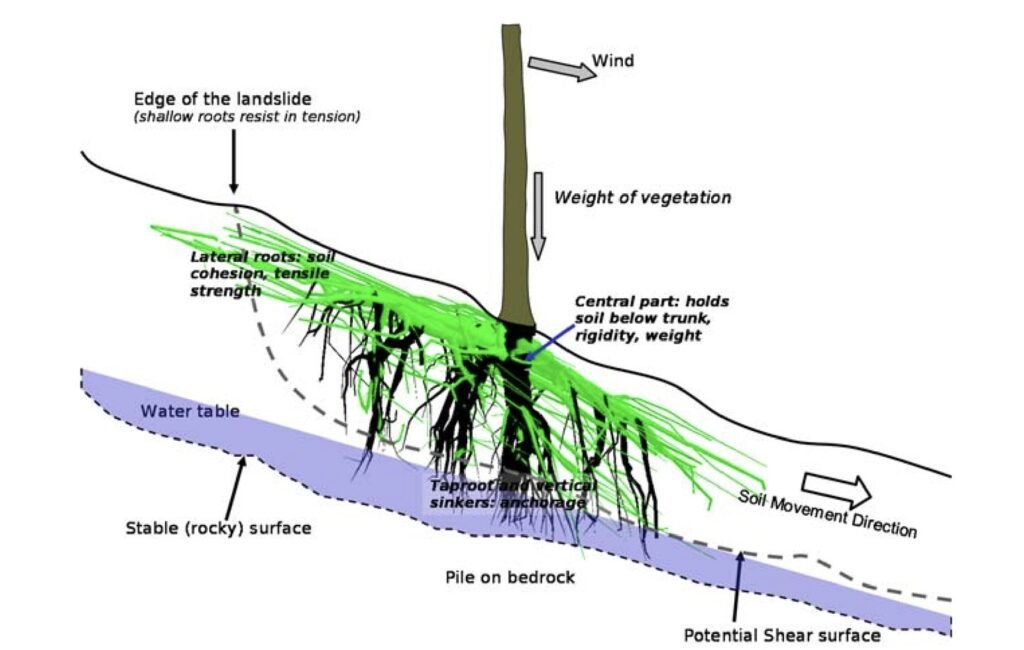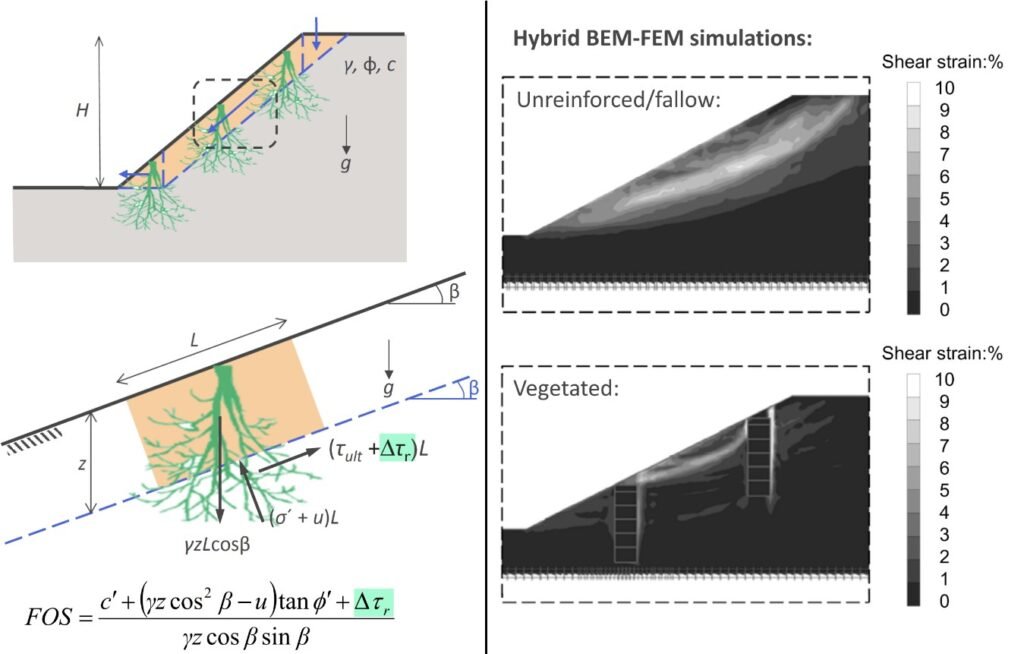

Bioengineering applied to slope stability
As Richards & Copin (2007) point out, the engineering use of vegetation is called "bioengineering", and basically consists of the use of living plant material to perform engineering functions. Although bioengineering has been applied empirically over the centuries, a major research effort is currently underway at top universities around the world to establish a framework for the formal application of bioengineering in civil projects. Do you want to learn more about the state of the art of bioengineering applied to slope stability? Continue reading this post...
Content
What is bioengineering?
The engineered use of vegetation is referred to as "bioengineering" (Richards & Coppin, 2007). As noted by Norris et al (2008), soil bioengineering uses living plant material to perform engineering functions.
Although the use of vegetation for slope stabilization began in ancient times, the formal adoption and development of this technology has been very slow, primarily due to the difficulty engineers face when attempting to quantify the beneficial effects of vegetation on stability.
A good compilation of examples of ancient stabilization and erosion control techniques was published some years ago by Geori & Stathakapoulos (2006). Figure 1 shows an illustrative figure of these ancient techniques.

Figure 1 Application of ancient bioengineering techniques for slope stability and erosion control. (Source: Geori & Stathakapoulos, 2006)
The difficulty associated with the quantification of the effects of vegetation on slope stability arises due to the conjunction of three aspects:
- The complexity of the phenomena involved in vegetation-terrain interaction.
- The relative scarcity of systematic experimental data.
- The limitations of modeling tools.
However, as will be seen below, an important research and development effort is currently underway in bioengineering applied to Geotechnics, as part of the actions focused on minimizing the effects of climate change.
Soil-vegetation interaction in slope stability problems
Something important to take into account in relation to the application of bioengineering solutions is that the beneficial effects of vegetation on slope stability develop gradually over a period of time, through complex mechanisms of interaction between roots and soil. These mechanisms associated with such effects are well identified at a conceptual level, as pointed out by Wu et al (2015):
- Plant roots act as mechanical reinforcement, providing tensile strength that is absent in most soils and, as they intercept potential sliding/shearing surfaces, is mobilized through a mixture of bending and pulling mechanisms.
- Roots modify the hydraulic condition of soils, affecting (and being affected by) soil water content, applying suction to feed evapotranspiration, and creating partially saturated conditions.
In addition, it is necessary to consider the geometry and arrangement of the roots, since deeper roots can act as anchors if they cross the potential failure surface, and as elements that provide stability through resistance at the soil-root interface in the case of lateral roots, pseudo-parallel to the slip surface and anchored to the part of the soil upstream of the tensile crack. Figure 2 shows schematically the above.

Figure 2 Contribution of roots to slope stability in surface landslides: 1) roots acting as anchors; 2) lateral roots acting as tension elements anchored upstream of the tensile crack. (Source: modified from Reubens et al, 2007)
One of the most complex aspects of the soil-root interaction problem is that the mechanical reinforcement effect and the hydraulic effect, mediated by suction, interact with each other. Another difficulty associated with modeling soil-root interaction is the geometric complexity and variability of root architectures. Such variability seriously complicates purely empirical approaches, based on systematic experimental data collection and identification of relevant factors.
From a practical point of view, there are adaptations of some traditional procedures used to analyze slope stability to consider the beneficial effect of roots (see, for example, Reubens et al, 2007; Wu et al, 2015). Additionally, more complex methods, based on finite elements, can be used to analyze the problem considering variations in hydraulic conditions (see, for example, Liang et al, 2015).

Figure 3 Analysis methodologies to consider the effect of roots in slope stability analysis. (Source: modified from Knapett, 2018).
Bioengineering applied to slope stability
There is overwhelming consensus among scientists that human-induced global warming has caused profound alterations in natural and human ecosystems.
In this context, and in order to minimize such alterations, computational simulation is currently considered key to accelerate research on root-soil interaction, as it allows generalizing the findings of empirical research through virtual models in which the numerous variables that are present in the field can be modified in a systematic and controlled way (Stubbs et al, 2019).
However, it is important to highlight that, in order to validate the virtual models, it is necessary to contrast them with the results of physical experiments. In that sense, to date, some laboratory investigations have been developed, including the use of the centrifuge (Liang et al, 2020; Sonnenberg et al, 2012; Zhang et al, 2020), the realization of 1-g models (Zhang et al, 2020), and the analysis of the hydromechanical behavior of rooted soil in partially saturated conditions (Fraccica et al, 2022).
In general, these investigations report the beneficial effect of roots on slope stability by providing additional strength to the soil. However, with the exception of the aforementioned research by Fraccica et al (2022), the literature reviewed does not report any laboratory studies that consider partially saturated conditions, which significantly modify the fundamental engineering properties of soils (Gens, 2010), thus affecting the behavior of the soil-root interface.
To complement those investigations, a major research effort is currently underway at the world's top universities to establish a framework for the formal application of bioengineering in civil projects.
References
- Geori & Stathakapoulos (2006) “Bioengineering techniques for soil erosion protection and slope stabilization”. Disponible en https://www.researchgate.net/
- Norris, J. E., Stokes, A., Mickovski, S. B., Cammeraat, E., van Beek, R., Nicoll, B. C., & Achim, A. (Eds.). (2008) “Slope Stability and Erosion Control: Ecotechnological Solutions”. Springer Netherlands.
- Reubens et al (2007) “The role of fine and coarse roots in shallow slope stability and soil erosion control with a focus on root system architecture: a review”. Trees (2007) 21:385–402 DOI 10.1007/s00468-007-0132-4
- Richards, I. G., & Coppin, N. J. (Eds.). (2007) “Use of vegetation in Civil Engineering”. (Reprinted 2007). CIRIA.
- Wu, W., Switala, B. M., Acharya, M. S., Tamagnini, R., Auer, M., Graf, F., te Kamp, L., & Xiang, W. (2015) “Effect of Vegetation on Stability of Soil Slopes: Numerical Aspect”. En W. Wu (Ed.), Recent Advances in Modeling Landslides and Debris Flows (pp. 163-177). Springer International Publishing. https://doi.org/10.1007/978-3-319-11053-0_15